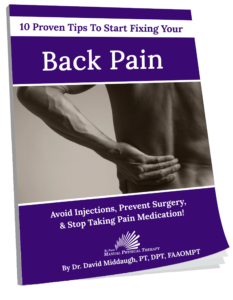TAP TO CALL (915) 503-1314

Can A Stuck Or Shifted Tailbone Cause Lower Back Pain?
Have you ever fallen on your tailbone and then began to have back pain and you’ve never really resolved that problem, you still dealing with back problems and you think that it might be connected to that time that you fell in your tailbone. Want today’s video I’m going to explain why that is there’s a real reason that the tailbone can be causing your back pain problem.
My name is Dr. David Mann off and I’m a specialist physical therapist at El Paso manual physical therapy. We help people stay healthy, active and mobile while avoiding unnecessary surgery, injections and pain medications. Please subscribe to our channel so that you don’t miss out on any of the helpful videos that we post every single week where we teach are about the body and we teach exercises and ways to improve your health.
Let’s get on to this. So let’s go over some quick anatomy first. Here you’ve got the tailbone. It’s called the sacrum and it connected to it down here to the Cox six. The purpose of the tailbone is multiple things, the biggest ones is to connect the pelvis bones together. So these bones out here the pelvis bones which formed the hip joints out here, they those pelvis bones connect on the front, right in here.
And the sacrum here is the base of the rest of the spine moving up so here you can see the bottom most disk here’s l five l 4321. l five has a disc under it and that this sits right on top of the grimmer we call it s one. And the sacrum is basically a bunch of vertebrae fused together.
That’s why you have bumps on it and nerves just like you’d have appear in the spine. Now, if you’ve ever fallen on your tailbone if you’ve fallen on your butt, basically and hit this part of your tailbone. It is possible for this bone to shift sideways or rotate or a combination of sideways and rotation.
Some people have had fractures to the area where they’ve fractured their toxics bone here they’ve even injured the joint because there’s a little bit of flexibility between the tail the sacrum and the the kocsis right here, this can deviate to the sides or this whole thing can deviate to the sides.
When the sacrum itself shifts over to the side, it shifts the foundation for the rest of the spine moving up especially at that joint immediately above it. So here in physical therapy at El Paso, manual physical therapy, we have techniques to be able to detect if this sacred this, this tailbone here is shifted over to one edge, we feel the edges out here. And then the bases up here we can feel if it’s shifted this way, or this way it’s rotated.
If that’s the case, then we’re looking at stuck joints in the area where the where the sacrum connects to the pelvis bones on the side. And we have techniques to free those up and there’s exercises to make sure that this stays mobile so that it’s not staying stuck. Now when people have shifted tailbone not only will they have pain kind of in the low low back almost a buttock area, but will tend to be on one side.
And the most common way that people come in and present to it. So you might have this experience yourself. It’s they’ll say this, they’ll say, Well, my back, it’s not really my back it kind of is my back, it’s more down here and it’s more on one side almost at the top of the but right in here.
They’re pointing to this joint that’s right here. That’s the same spot right here. The tailbone is right here and myself. It’s like an upside down triangle. So these edges are the edges of that tailbone with that sacrum. So if there’s a shift that it contention, the ligaments back there, it can tension the muscles, it can pinch the sciatic nerve which pops out right here.
There’s so many things that could happen that can cause hip pain and of course back pain. The main reason that people have back pain from a shifted tailbone if it’s been there for a while. The base of the sacrum right here where it connects to that disc will shift over and then it starts to add compression to the disk and if you move like that and live like that the muscles in adapt, and they can cause a lot of harmful forces to this disk and cost herniations there, that disk right there we call it the L five s one disc is the most commonly injured disc hands down.
The next one is the one right above this is the second most common L four or five disc. But I personally find this is not in the research. This is just from personal experience as a manual therapist is kind of an expert in the field. That most back problems whenever people have a disc herniation down here some l four l five problem.
Most back problems in this region in this problems have a sacral component that isn’t being addressed. This is why if you’ve ever been in physical therapy or Chiropractic and the sacrum wasn’t addressed, you might still have some lingering back pain. Maybe it got a little bit better.
Maybe if you had an injection. That’s another big one. People get an injection at the herniated disc level or wherever they have a pinched nerve and we’ll get some relief but it’s not always The weight gone. And if you’ve had that experience and your pains lower down in the edge where we hear even all the way near the, the, you know where the bug crack is right here though the gluteal cleft is the scientific name, just off to the side of it, that is your SI joint.
And if you hurt there, you’ve got an SI joint problem, a secretly act joint problem, which means you have a sacred problem. And that needs to be addressed. As far as exercises for this, there are some exercises out there, it really requires hands on work. And I’m sorry, I don’t have any access to show you on this video to fix a shifted sacrum.
But my best recommendation for you is to go find a specialist in your area who’s a manual therapist ideally, or maybe you might find a chiropractor that’s good at dealing with this stuff. Some chiropractors actually are in find somebody who can identify the problem first, they can identify it, they’re not going to be able to treat it.
If they can at least identify it, then you have a good shot at getting this problem addressed that you can completely resolve your back pain, it is not normal to have back pain as you ate. Some people just resolve that they just think, well, I’m in my 50s or 60s Now, I’ve been dealing with back pain, you got mostly better going to physical therapy or whatever treatment I did.
Still there, maybe one or two, you should feel fantastic. You should feel like you’re 25. Again, when it comes to your back and tailbone area, they should all feel fantastic here. There are some exercises to maintain the stability of things once we get it shifted in the right position. And for that we fall back to our usual weak muscles whenever there’s muscle imbalances here.
So glute muscles are the big one, the glute muscles come in and attach right over that SI joint in there and onto the sacrum itself. And along the edge of this pelvis bone here it’s the iliac. So the glute muscles are the number one muscles in bringing stability to this area a close second or abdominal muscles because abdominals attached to the rim of this bone, this pelvis bone, and they can help to maintain normal mobility in the SI joint.
There’s some other deeper glute muscles that attach in the area that also needs to be strong or provide the best ability. So being able to get great glute activation and having decent to great abdominal strength is necessary in order to keep your si joints healthy. If your si joints are chronically stuck, it’s possible to get arthritis in this joint and it’s already a stiff joint naturally compared to other joints in the spine.
But you should have a little bit of wiggle in this joint in order to properly live and do your everyday things exercise. Otherwise, you’ll feel you feel that back pain that comes on there is a surgery out there where they do an SI joint fusion. And it’s not the best procedure out there. I wouldn’t recommend getting it if you haven’t found somebody that can address the sacral position and move this SI joint then I would pursue that first before going to go get some surgery to fuse your SI joint.
And just a side note on that si joints need to move there’s a belief in there’s a school of thought some people in the medical field believe that si joints should not move because of of how stiff the joint is, they compare it to the joints in the skull.
These joints are almost fused. But it is possible to see some movement in the SI joint that’s why the sacred can shift. And there isn’t good research out there that shows that we can find it but if you look at the flaws in the research study, they aren’t people that are very experienced in finding it so that’s kind of a you know takes the carpet out from under them in their belief that they can’t feel the SI joint movement and the SI joint positions
Because they’re not experienced enough, they haven’t gone through the training and the and they have gotten the reps necessary to feel this. It’ll pass them into physical therapy we’re finding this problem on on so many people with back problems, and we’re correcting it and fully resolving their back pain.
So they’re not dealing with any back pain whatsoever. As long as they don’t have any arthritis. That is severe. You got any comments or questions? Please drop them below and if this video was helpful for you, give us a thumbs up and don’t forget to subscribe so you don’t miss out on any helpful videos that we put up every single week. Have a wonderful day friends.
Would You Like To Talk With A Specialist?
Appointments and Questions Call: (915)503-1314
EL PASO MANUAL PHYSICAL THERAPY
2601 E. Yandell Drive, Suite 232
El Paso, Texas 79903
© 2023 El Paso Manual Physical Therapy, PLLC, All Rights Reserved
